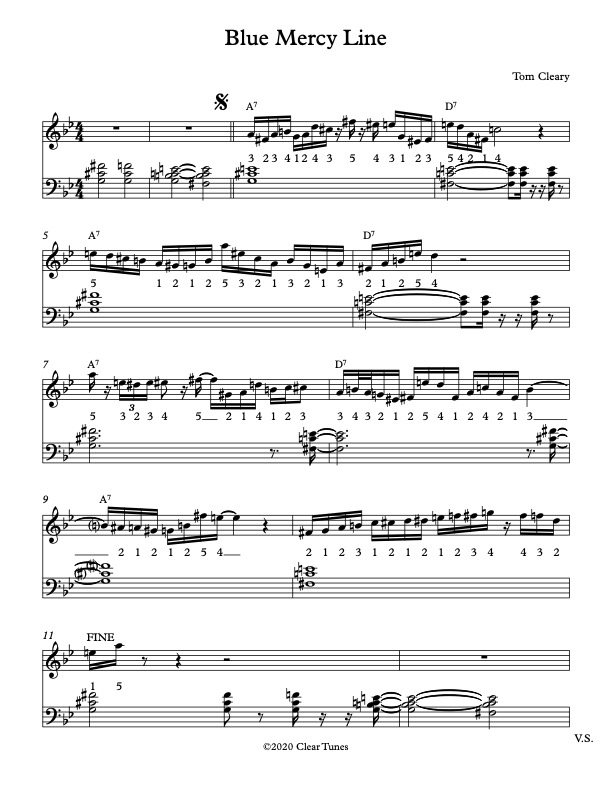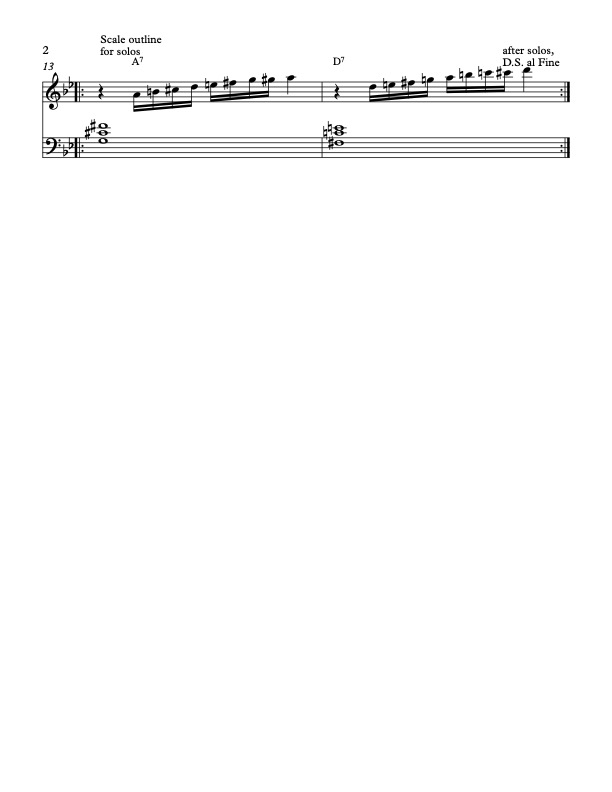Blue Mercy Line is a tune I composed on a chord progression in the key of A which could be described as A7-D7 or I7-IV7. I wrote this tune as an exercise in using the melodic language of Charlie Parker, specifically his B flat blues ‘Bloomdido’, as a source of ideas for improvising on the I-IV progression that is often used for solos on Josef Zawinul’s ‘Mercy, Mercy, Mercy’. This type of progression can also be heard in the middle section of ‘In A Silent Way‘, Miles Davis’s early, extended experiment in electric instrumentation, Eddie Harris’s solo on Les McCann’s ‘You Got It In Your Soulness’, and the solo section of ‘Jessica’ by The Allman Brothers. A similar progression also appears near the end of Mike Gordon’s tune ‘Another Door’, which I would often solo on during my years playing in his band (2008-14). This video of the end of the tune at Chicago’s Park West shows both how much fun I had playing in that band and how much trouble I had being adequately heard over the din of its stage volume. The I-IV progressions in these tunes also bear a resemblance to the imin7 – IV7 progressions heard in Herbie Hancock’s ‘Chameleon’ and Pink Floyd’s ‘Breathe’.
Cannonball Adderley’s original version of ‘Mercy, Mercy, Mercy’ is, along with Duke Ellington’s ‘Diminuendo and Crescendo in Blue’ and Ramsey Lewis’ version of ‘The In Crowd’ and ‘Hard Day’s Night’, one of the classic jazz recordings including audience participation. In the liner notes for a later Adderley album, Michael Cuscuna mentions that ‘Mercy, Mercy, Mercy’ was recorded not in a club but in a recording studio with an invited audience and an open bar. Josef Zawinul’s solo on Wurlitzer electric piano alternates between moving in eighth notes and moving in short bursts of sixteenth notes. The relaxed groove of the recording derives from the way Zawinul alternates between these two note values just enough to maintain a sense of forward motion in his solo.
In solos on later versions of the tune, like Tom Scott’s solo on the version of ‘Mercy, Mercy, Mercy’ from the tribute album Cannon Reloaded, longer strings of sixteenth notes become a vehicle for introducing bebop melodic moves, such as ‘enclosing’ or ‘surrounding’ scale steps with chromatic neighbor tones and adding half steps on upbeats between scale steps. Scott’s solo clearly shows the influence of Charlie Parker; my idea in composing ‘Blue Mercy line’ was to go directly to Scott’s likely source, Parker’s improvising as shown in the transcriptions from the ‘Charlie Parker Omnibook’, for ideas on how to construct a bop-style melodic line on a I-IV vamp. I studied ways that Parker melodically navigated the change from the I7 to the IV7 chord during the blues progression in ‘Bloomdido’, and integrated them into a new melodic line over a I-IV vamp.
I originally conceived Blue Mercy Line to be played at the tempo of ‘Mercy, Mercy, Mercy’, and I performed it that way several times. After my friend bassist Paul Rogalski (of the band Mojomama) posted a bass-and-drum groove on Facebook in the key of A, I realized ‘Blue Mercy’ could also work at this tempo, which is similar the tempo of ‘Another Door’. The recording posted below features Rogalski’s virtuosic popping and slapping on electric bass.

